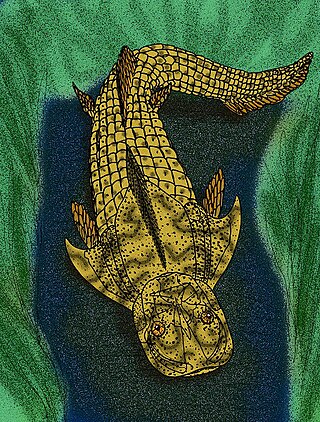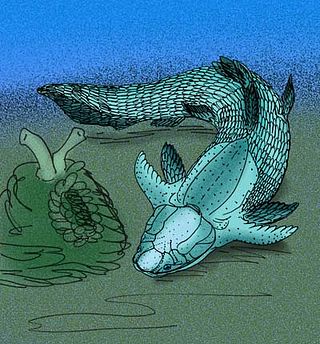
Dunkleosteus is an extinct genus of large arthrodire ("jointed-neck") fish that existed during the Late Devonian period, about 382–358 million years ago. It was a pelagic fish inhabiting open waters, and one of the first apex predators of any ecosystem.

Arthrodira is an order of extinct armored, jawed fishes of the class Placodermi that flourished in the Devonian period before their sudden extinction, surviving for about 50 million years and penetrating most marine ecological niches. Arthrodires were the largest and most diverse of all groups of placoderms.

Titanichthys is an extinct genus of giant, aberrant marine placoderm from shallow seas of the Late Devonian of Morocco, Eastern North America, and possibly Europe. Many of the species approached Dunkleosteus in size and build. Unlike its relative, however, the various species of Titanichthys had small, ineffective-looking mouth-plates that lacked a sharp cutting edge. It is assumed that Titanichthys was a filter feeder that used its capacious mouth to swallow or inhale schools of small, anchovy-like fish, or possibly krill-like zooplankton, and that the mouth-plates retained the prey while allowing the water to escape as it closed its mouth. A study has since confirmed this assumption as its jaws are functionally closer to that of filter feeders like baleen whales and basking sharks, and it appears to have developed from benthic durophagists that became pelagic suspension feeders. This would make it the first (known) large-sized vertebrate filter feeder. Titanichthys was estimated to have reached a length of 7–7.6 m (23–25 ft), but Engelman (2023) suggested that Titanichthys was comparable in size to Dunkleosteus, likely measuring about or just over 4.1 metres (13.5 ft) in length.

Arctolepis is an extinct genus of placoderm arthrodire fish which lived during the Early Devonian period. Fossils of Arctolepis have been found in what is now Norway and Michigan.

Dicksonosteus is an extinct genus of basal arthrodire placoderm fish which lived during the Early Devonian period of Spitsbergen, Norway.

Aleosteus is an extinct monospecific genus of arthrodire placoderm fish of the Early Devonian period. The type species Aleosteus eganensis was described in 2000, and was found in the Late Emsian strate of the Sevy Dolomite Formation, in the Egan Range of east-central Nevada, USA. Almost complete fossils belong to juvenile and adult specimens and show a short and broad skull, posteriorly concave.

Plourdosteus is an extinct genus of placoderm arthrodire which was relatively widespread in Euramerica during the Givetian to Frasnian ages of the Devonian. It was a small placoderm, with P. canadensis specimen MNHM 2-177 measuring 37.5 cm (14.8 in) long.

Mcnamaraspis is an extinct monospecific genus of arthrodire placoderm that inhabited the ancient reef system of north Western Australia during the Frasnian epoch of the Late Devonian period. The type specimen was found and described by John A. Long from the Gogo Formation near Fitzroy Crossing. This fossil fish showed new anatomical features in arthrodires, like the well-preserved annular (ring-shaped) cartilages of the snout, previously inferred to be present by Erik Stensiö of Sweden. It is occasionally referred to as "The Gogo Fish" after the locale the holotype was excavated from.

Wuttagoonaspis is a extinct genus of primitive arthrodire placoderm fish from the Middle Devonian of Australia. The box-like skull is up to 18 centimeters in length, and the median dorsal plate averages in length about 10 centimeters. It contains two species: the type species Wuttagoonaspis fletcheri, described by Ritchie in 1973, and Wuttagoonaspis milligani, described by Young and Goujet in 2003.

Yiminaspis is an extinct monospecific genus of primitive arthrodire placoderm fish from Emsian-aged marine strata in Yunnan, China. The type species Yiminaspis shenme was named and described in 2008, and is known from a flattened partial skull and portions of the thoracic armor.

The Beartooth Butte Formation is a geologic formation in Wyoming. It preserves fossils dating back to the Devonian period.
Yujiangolepis is an extinct monospecific genus of arthrodire placoderm fish from the Pragian stage of the Devonian period. The type species is Yujiangolepis liujingensis, described from a single incomplete skull roof from the Nakaoling (Nagaoling) Formation of Hengxian, Guangxi, South China. It is one of the more basal members of the order Arthrodira, closely related to Antarctaspis, as shown in the cladogram below:

Antarctaspis is an extinct monospecific genus of arthrodire placoderm fish which existed in Antarctica during the Devonian period. The type species Antarctaspis mcmurdoensis was described White in 1968, and is known from a partial head shield discovered in the Lashly Mountains of Antarctica. It is one of the more basal members of the order Arthrodira, closely related to Yujiangolepis, as shown in the cladogram below:
Aethaspis is an extinct genus of arthrodire placoderm fish from the Devonian period. Two species were described by Denison in 1958: Aethapsis major and Aethapsis utahensis. It is one of the more basal members of the order Arthrodira, as shown in the cladogram below:
Lehmanosteus is an extinct monospecific genus of arthrodire placoderm fish, named after French paleontologist Jean-Pierre Lehman. The type species Lehmanosteus hyperboreus was described in 1984, and was found in Early Devonian strata of the Wood Bay Formation on the island of Spitsbergen, Svalbard in Norway.
Simblaspis is an extinct monospecific genus of arthrodire placoderm fish of the Early Devonian period. The type species Aleosteus eganensis was described in 1958, and was found in Pragian strata of the Qasr Limestone in Saudi Arabia.
Murmur is a genus of placoderm. The type species is Murmur arctatum. It was described from a fossil found at Beartooth Butte, Wyoming.

Kujdanowiaspis is an extinct genus of arthrodire placoderm fish from the Early Devonian of Podolia (Ukraine), Poland and Spain. Kujdanowiaspis is known from many fragmentary head shields and body armours.

Bryantolepis is an extinct genus of arthrodire placoderm fish from the Early Devonian period found in northern USA, and currently consists of two species, Bryantolepis brachycephala and Bryantolepis williamsi. The genus is known from multiple parts of the skull roof, the suborbital, endocranium, and trunk shield.
Erikaspis is an extinct monospecific genus of arthrodire placoderm fish found in Lochkovian-Pragian deposits of Podolia, Western Ukraine. The type species Erikaspis zychi was originally described in 1945 by Erik Stensiö based on a partial skull-roof, and was named Kujdanowiaspis zychi. In 2007, it was subsequently reassigned to the newly named genus Erikaspis, based on significant differences from Kujdanowiaspis.





















